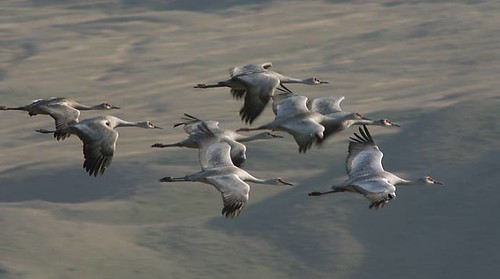Birds In The News #9: Day of Redemption
Even if you live in the White House, you are well aware that the Lord God, in all his glory, appeared recently in a swamp in Arkansas to several people, some of whom even caught him on video! The most astounding news of all? God is a Bird, locally known as the "Lord God Bird".
For more information about these amazing sightings of the "extinct" ivory-billed woodpecker, see my plethora (eight total) of blog entries from yesterday, entries that include exclusive confidential emails from several of the observers, also photographs, paintings, video clips, maps and links to several dozen radio, television and newspaper clips. To read any or all of this material, click on any of the top eight titles in the sidebar, on left.
In other news linked from today's issue of Birds in the News, my "peeps" and I found several interesting stories for your reading pleasure. These stories include articles about how songbirds are teaching us more about ourselves by helping us understand learning and memory. Another story shows how birds continue their valuable role as "canaries in the coal mine", but with regards to warning us about environmental pesticides that were thought to be long gone.
Additionally, a reader found a film trailer for a documentary film about parrots in San Francisco that I share with you here, I link to more exciting news about the five kakapo chicks of New Zealand, and to an interesting story about a "bird landlord" in rural Wisconsin. Of course, I cannot neglect to mention some conservation news where construction of a hotel is threatening to wipe out a significant proportion of an already endangered species of thrasher from its island paradise.
And last but certainly not least, is the featured reader photoblog, a stunning photograph of migrating sandhill cranes, Grus canadensis, which are close relatives to the endangered (but recovering) whooping cranes, Grus americana.
I hope you enjoy! If you have an interesting link that you'd like to share, or if you have taken a bird photograph that you wish to share with my readers, send it to me and I'll add it to next week's edition of Birds in the News.
Birds in Science:
One of my most favorite topics is birdsong (indeed, birdsong was so attractive that this research field lured me from cancer research into avian research). Bird song is the main model system for understanding learning and memory; how learning occurs, how memories are formed and how they function to produce a complex behavior such as birdsong. Basically, we know that distinct neural pathways are involved in song learning and memory, but the details remain mysterious. In these articles, scientists reveal that they have taken a major step forward in understanding one previously unknown step in the learning pathway that is common to humans and birds; understanding how the "playful variability in the little bird's babble" arose in the first place (read original press release here).
One of Florida's largest lakes, Lake Apopka, is teaming with bird species. In fact, "This lake has more species than any Florida lake I've ever been to," says scientist Lee Walton of Biological Research Associates in Tampa. "And we go to a lot of lakes." But does a large population of bird species signify that the lake and its surrounding ecosystem are healthy? After a huge bird die off in 1998 that was probably due to pesticide exposure, scientists wondered the same thing. To answer this question, they began testing bird eggs, looking for pesticides. This story shows that they found evidence of DDT in a significant proportion of eggs tested, which should serve as a warning that people should be more careful of what they put into the environment, especially because pesticides are toxic to humans, too. "We didn't expect that things would take so long to leave the environment," Walton concludes. [requires free registration]
People hurting Birds:
 As a primary example that people, Homo hubris, are slow learners that stubbornly persist in their selfish and destructive behavior, a hotel and residential estate development on the Caribbean island of St. Lucia threatens almost a quarter of the world's total population of the white-breasted thrasher, Ramphocinclus brachyurus, an already endangered species. Astonishingly, a preliminary study carried out by an US company found no endangered species in the proposed development area even though it is well-documented that 138 breeding pairs of white-breasted thrashers – approximately 22% of the world population – are known to live and breed in this particular area slated for destruction.
As a primary example that people, Homo hubris, are slow learners that stubbornly persist in their selfish and destructive behavior, a hotel and residential estate development on the Caribbean island of St. Lucia threatens almost a quarter of the world's total population of the white-breasted thrasher, Ramphocinclus brachyurus, an already endangered species. Astonishingly, a preliminary study carried out by an US company found no endangered species in the proposed development area even though it is well-documented that 138 breeding pairs of white-breasted thrashers – approximately 22% of the world population – are known to live and breed in this particular area slated for destruction. People helping Birds:
The good news from New Zealand continues; the Department of Conservation's Kakapo Team are watching over five rare kakapo chicks, Strigops habroptilus, on Codfish Island/Whenua Hou off the bottom tip of New Zealand. The kakapo is a large, flightless nocturnal parrot that looks like a green owl and nests in burrows. This species nearly became extinct because rats and other introduced predators killed and ate their eggs, chicks and incubating hens. This story includes several cute pictures of the endangered parrots and their chicks, too.
What, you ask, is a "bird landlord"?? Well, meet Bird Landlord Duane Zabel of Manitowoc, Wisconsin, who tells you about his job maintaining 108 bird houses. His desired tenants? Eastern bluebirds, although he ends up providing housing for other native avian species as well, primarily tree swallows along with some wrens and chickadees. There are three species of bluebirds in North America. They are insectivorous birds and therefore are a valuable control for insect populations. The introduced English sparrow has displaced bluebirds throughout much of its range by out-competing them for nesting spaces. Bird landlords, as Zabel describes in this article, are helping to increase bluebird populations throughout the United States, where they once were more common, by providing nest boxes to them.
How much does it cost to protect an endangered species? In this short newsbrief, the US Fish and Wildlife Agency estimates the cost of protecting the endangered Southwestern willow flycatcher, Empidonax traillii extimus, will be between $29.2 million to $39.5 million per year.
Birds and Entertainment:
Birdwatching is no longer an activity solely reserved for lonely little blue-haired ladies. There are several rapidly growing bird watching activities known as "listing" or "twitching" and occasionally as "extreme birding", that are sweeping the country. Further, birdwatching is a social and competitive event, too. In one such popular competitive team event known as the "Big Day", a team of four bird watchers seek out and list as many bird species as they can possibly see in a 24-hour time period. This past Wednesday, a team in Los Angeles significantly surpassed the old LA county record of 182 species for a "big day", as this article reveals; Bird-watchers feather nest with record.
It's true that I have a passion for parrots (and all birds), but like many people, I am reluctant to waste my hard-earned money on a silly films because, well, I have taste (and I am also broke). But even those people who don't have the level of passion that I have for birds report that they enjoyed the documentary film, Wild Parrots of Telegraph Hill. After I saw this trailer for the film, I agree that this is a charming little must-see film. Tell me if you also agree!
Reader Photoblog:
This week's reader photoblog entry comes from amateur photographer and birder, Steve Taylor in Washington State, who recently took this spectacular photograph of migrating sandhill cranes.

Steve writes: The official start of Spring for my wife and me is our annual trip to central Washington State to see the migrating Sandhill Cranes.
Seeing these magnificent birds gives us both a sense of beginning and also a sense of timelessness. Beginning because the migration signals the beginning of the breeding cycle and timelessness because Cranes have been migrating like this for thousands, perhaps millions, of years.
The cranes have their own rituals. As part of their annual migration, they stop for around a month to rest and gain weight for the remainder of their flight. Within this rest period, they have daily rituals as well. Every morning they move from their roosting site to a nearby corn field where they feed for several hours. After feeding, they move to a day roost. In the late afternoon they repeat the cycle, going to feed and then flying to a night roost. Finding a vantage point to watch these daily flights is a priority for us and every year is different because the location of the corn fields changes.
This year, the birds were spending their days in an area known as Corfu in Grant County, Washington. There were excellent views of their daily movements from a road known as C southeast. C southeast sits on a gradual upslope about a mile and a half from Lower Crab Creek which was the day roost for a large number of Cranes this year. Beyond Lower Crab Creek, the land rises sharply to the Saddle Mountains. This geography combined with a 300mm lens and a 2x doubler gave me the opportunity to shoot some pictures as if I were flying above the Cranes. The late afternoon light was the final ingredient needed to produce the picture you see here.
Previous : : Birds in the News : : Next
Academic Interviews: 1
Academic Job Offer (in the works): 1, for Adjunct Assistant Professor of Genetics at a real university.
Academic Job Rejections: 1 (Assistant Professor of Biology)
© 2004, 2005, 2006 by GrrlScientist











3 Peer Reviews:
Great update on this week's bird stories.
The photograph of migrating sand hill cranes is just breathtaking.
I am really so happy to read about your the job possibilities. It sounds very promising.
What a wonderful photo! I can almost feel as if I am gliding with them on a spring break.
Thanks for enjoying the photograph! I'll let Steve know that he has some comments here to read about his picture. He has more stunning pictures on his webpage that I linked to, also. Your reaction to that photo was the same as mine when I first saw it; I felt I was flying alongside those sandhill cranes, I could almost feel the wind blowing into my teary eyes and almost hear their throaty calls, in fact. And I fell in love again with the Palouse, as I do every year. Ah, such a sweet and sad feeling love is ..
There is so much more that I want to say about my job possibilities .. so much, but not on my blog (yet). But maybe, hopefully, soon?
Post a Comment
<< Home